Human Resource Management Assignment: NSBM, Year 2, Semester 2
VerifiedAdded on 2022/01/18
|12
|4521
|25
Homework Assignment
AI Summary
This assignment solution from NSBM, Year 2, Semester 2, Module MGT 2307, addresses key aspects of Human Resource Management. It begins by defining HRM and its core functions, distinguishing between hard and soft HRM approaches. The assignment then explores HR planning, emphasizing forecasting and strategic decision-making. It further delves into reward management systems, detailing pay, welfare, and incentive management, along with factors influencing pay. The impact of the COVID-19 pandemic on employee health and safety is analyzed, emphasizing preventative measures. Finally, the assignment discusses training and development programs, their impact on employee performance, and organizational success. The document concludes with a scenario of employee turnover in a finance department, providing a comprehensive overview of HRM principles and practices.
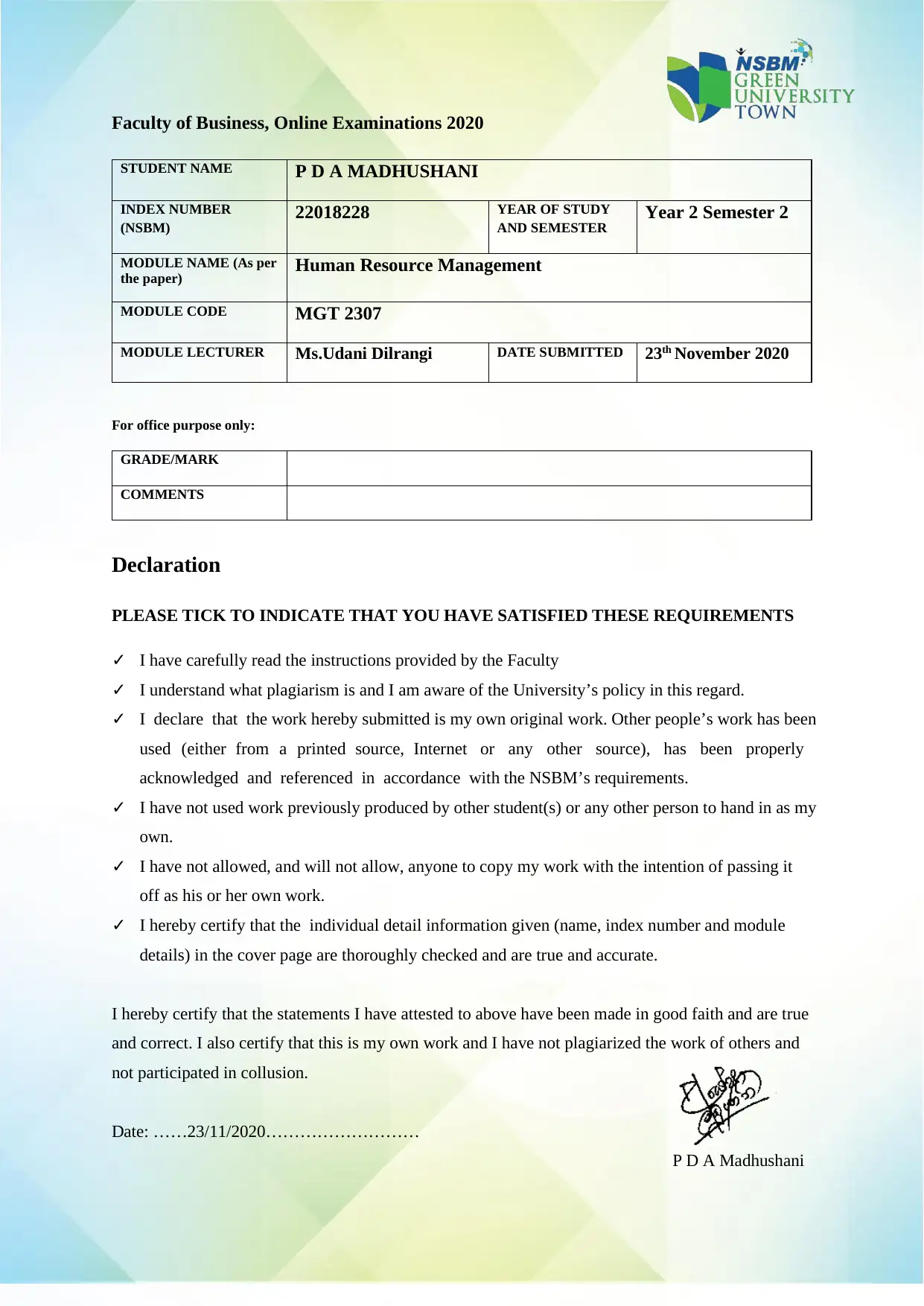
Faculty of Business, Online Examinations 2020
STUDENT NAME P D A MADHUSHANI
INDEX NUMBER
(NSBM)
22018228 YEAR OF STUDY
AND SEMESTER
Year 2 Semester 2
MODULE NAME (As per
the paper) Human Resource Management
MODULE CODE MGT 2307
MODULE LECTURER Ms.Udani Dilrangi DATE SUBMITTED 23th November 2020
For office purpose only:
GRADE/MARK
COMMENTS
Declaration
PLEASE TICK TO INDICATE THAT YOU HAVE SATISFIED THESE REQUIREMENTS
✓ I have carefully read the instructions provided by the Faculty
✓ I understand what plagiarism is and I am aware of the University’s policy in this regard.
✓ I declare that the work hereby submitted is my own original work. Other people’s work has been
used (either from a printed source, Internet or any other source), has been properly
acknowledged and referenced in accordance with the NSBM’s requirements.
✓ I have not used work previously produced by other student(s) or any other person to hand in as my
own.
✓ I have not allowed, and will not allow, anyone to copy my work with the intention of passing it
off as his or her own work.
✓ I hereby certify that the individual detail information given (name, index number and module
details) in the cover page are thoroughly checked and are true and accurate.
I hereby certify that the statements I have attested to above have been made in good faith and are true
and correct. I also certify that this is my own work and I have not plagiarized the work of others and
not participated in collusion.
Date: ……23/11/2020………………………
P D A Madhushani
STUDENT NAME P D A MADHUSHANI
INDEX NUMBER
(NSBM)
22018228 YEAR OF STUDY
AND SEMESTER
Year 2 Semester 2
MODULE NAME (As per
the paper) Human Resource Management
MODULE CODE MGT 2307
MODULE LECTURER Ms.Udani Dilrangi DATE SUBMITTED 23th November 2020
For office purpose only:
GRADE/MARK
COMMENTS
Declaration
PLEASE TICK TO INDICATE THAT YOU HAVE SATISFIED THESE REQUIREMENTS
✓ I have carefully read the instructions provided by the Faculty
✓ I understand what plagiarism is and I am aware of the University’s policy in this regard.
✓ I declare that the work hereby submitted is my own original work. Other people’s work has been
used (either from a printed source, Internet or any other source), has been properly
acknowledged and referenced in accordance with the NSBM’s requirements.
✓ I have not used work previously produced by other student(s) or any other person to hand in as my
own.
✓ I have not allowed, and will not allow, anyone to copy my work with the intention of passing it
off as his or her own work.
✓ I hereby certify that the individual detail information given (name, index number and module
details) in the cover page are thoroughly checked and are true and accurate.
I hereby certify that the statements I have attested to above have been made in good faith and are true
and correct. I also certify that this is my own work and I have not plagiarized the work of others and
not participated in collusion.
Date: ……23/11/2020………………………
P D A Madhushani
Paraphrase This Document
Need a fresh take? Get an instant paraphrase of this document with our AI Paraphraser
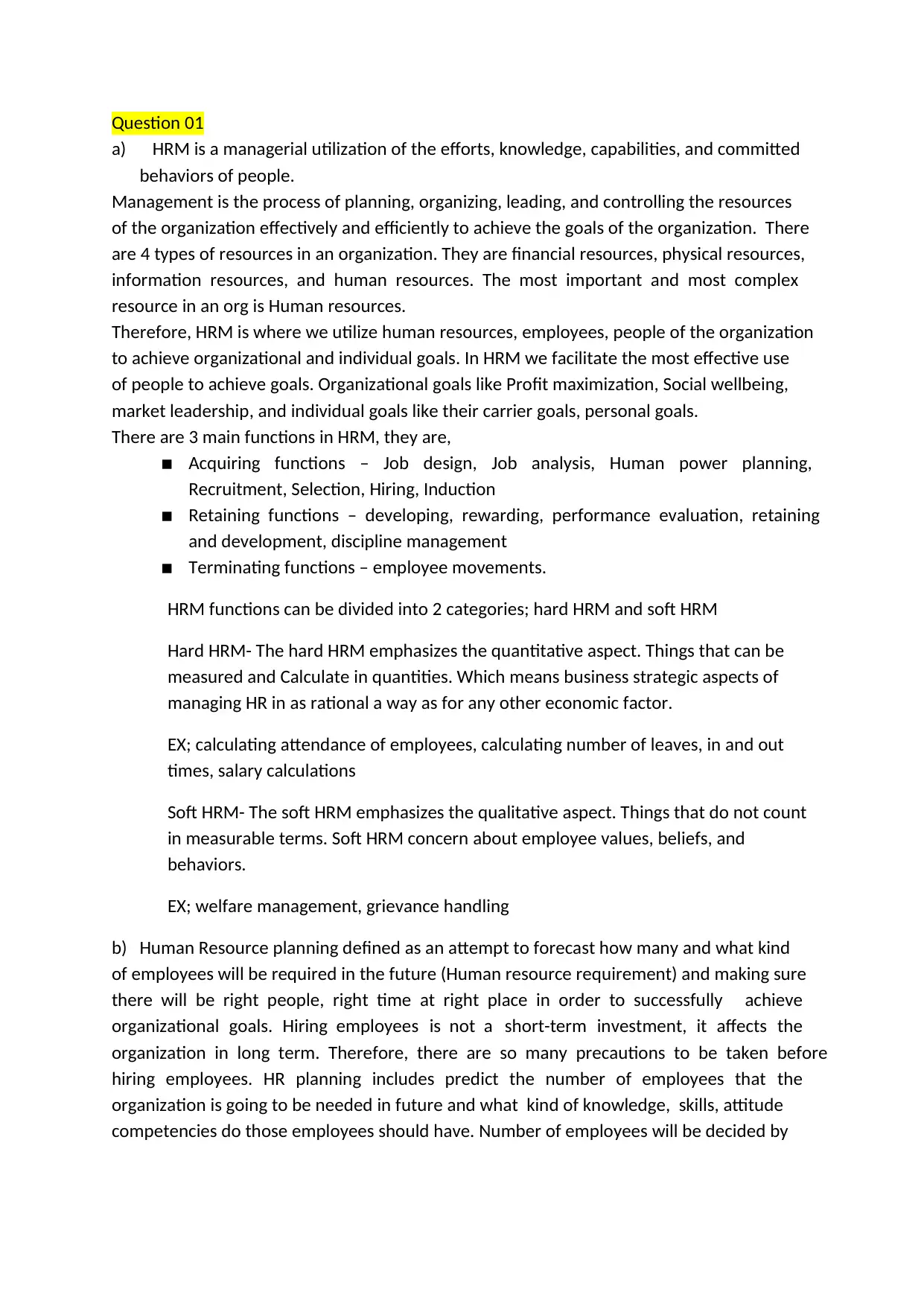
Question 01
a) HRM is a managerial utilization of the efforts, knowledge, capabilities, and committed
behaviors of people.
Management is the process of planning, organizing, leading, and controlling the resources
of the organization effectively and efficiently to achieve the goals of the organization. There
are 4 types of resources in an organization. They are financial resources, physical resources,
information resources, and human resources. The most important and most complex
resource in an org is Human resources.
Therefore, HRM is where we utilize human resources, employees, people of the organization
to achieve organizational and individual goals. In HRM we facilitate the most effective use
of people to achieve goals. Organizational goals like Profit maximization, Social wellbeing,
market leadership, and individual goals like their carrier goals, personal goals.
There are 3 main functions in HRM, they are,
▪ Acquiring functions – Job design, Job analysis, Human power planning,
Recruitment, Selection, Hiring, Induction
▪ Retaining functions – developing, rewarding, performance evaluation, retaining
and development, discipline management
▪ Terminating functions – employee movements.
HRM functions can be divided into 2 categories; hard HRM and soft HRM
Hard HRM- The hard HRM emphasizes the quantitative aspect. Things that can be
measured and Calculate in quantities. Which means business strategic aspects of
managing HR in as rational a way as for any other economic factor.
EX; calculating attendance of employees, calculating number of leaves, in and out
times, salary calculations
Soft HRM- The soft HRM emphasizes the qualitative aspect. Things that do not count
in measurable terms. Soft HRM concern about employee values, beliefs, and
behaviors.
EX; welfare management, grievance handling
b) Human Resource planning defined as an attempt to forecast how many and what kind
of employees will be required in the future (Human resource requirement) and making sure
there will be right people, right time at right place in order to successfully achieve
organizational goals. Hiring employees is not a short-term investment, it affects the
organization in long term. Therefore, there are so many precautions to be taken before
hiring employees. HR planning includes predict the number of employees that the
organization is going to be needed in future and what kind of knowledge, skills, attitude
competencies do those employees should have. Number of employees will be decided by
a) HRM is a managerial utilization of the efforts, knowledge, capabilities, and committed
behaviors of people.
Management is the process of planning, organizing, leading, and controlling the resources
of the organization effectively and efficiently to achieve the goals of the organization. There
are 4 types of resources in an organization. They are financial resources, physical resources,
information resources, and human resources. The most important and most complex
resource in an org is Human resources.
Therefore, HRM is where we utilize human resources, employees, people of the organization
to achieve organizational and individual goals. In HRM we facilitate the most effective use
of people to achieve goals. Organizational goals like Profit maximization, Social wellbeing,
market leadership, and individual goals like their carrier goals, personal goals.
There are 3 main functions in HRM, they are,
▪ Acquiring functions – Job design, Job analysis, Human power planning,
Recruitment, Selection, Hiring, Induction
▪ Retaining functions – developing, rewarding, performance evaluation, retaining
and development, discipline management
▪ Terminating functions – employee movements.
HRM functions can be divided into 2 categories; hard HRM and soft HRM
Hard HRM- The hard HRM emphasizes the quantitative aspect. Things that can be
measured and Calculate in quantities. Which means business strategic aspects of
managing HR in as rational a way as for any other economic factor.
EX; calculating attendance of employees, calculating number of leaves, in and out
times, salary calculations
Soft HRM- The soft HRM emphasizes the qualitative aspect. Things that do not count
in measurable terms. Soft HRM concern about employee values, beliefs, and
behaviors.
EX; welfare management, grievance handling
b) Human Resource planning defined as an attempt to forecast how many and what kind
of employees will be required in the future (Human resource requirement) and making sure
there will be right people, right time at right place in order to successfully achieve
organizational goals. Hiring employees is not a short-term investment, it affects the
organization in long term. Therefore, there are so many precautions to be taken before
hiring employees. HR planning includes predict the number of employees that the
organization is going to be needed in future and what kind of knowledge, skills, attitude
competencies do those employees should have. Number of employees will be decided by
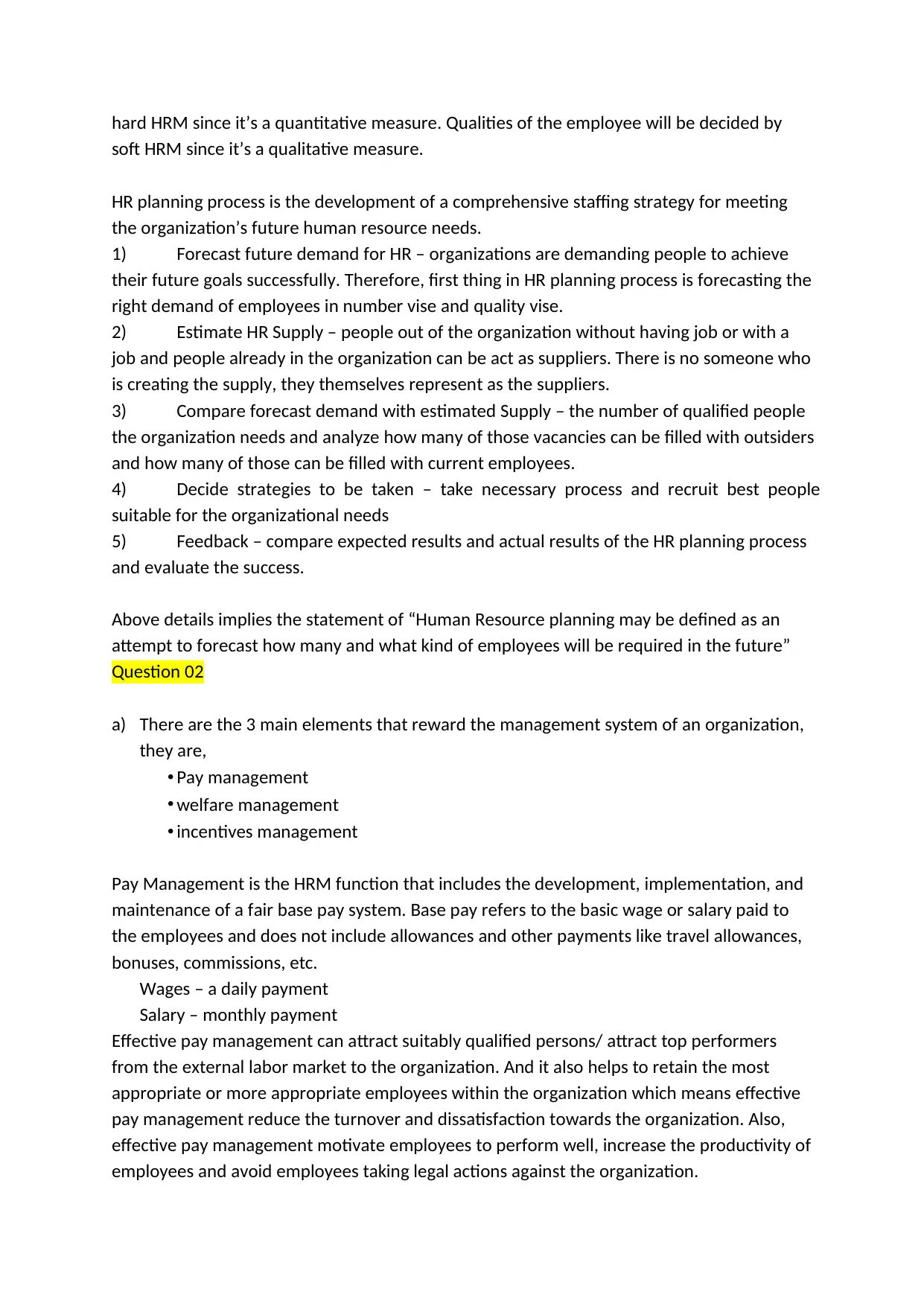
hard HRM since it’s a quantitative measure. Qualities of the employee will be decided by
soft HRM since it’s a qualitative measure.
HR planning process is the development of a comprehensive staffing strategy for meeting
the organization’s future human resource needs.
1) Forecast future demand for HR – organizations are demanding people to achieve
their future goals successfully. Therefore, first thing in HR planning process is forecasting the
right demand of employees in number vise and quality vise.
2) Estimate HR Supply – people out of the organization without having job or with a
job and people already in the organization can be act as suppliers. There is no someone who
is creating the supply, they themselves represent as the suppliers.
3) Compare forecast demand with estimated Supply – the number of qualified people
the organization needs and analyze how many of those vacancies can be filled with outsiders
and how many of those can be filled with current employees.
4) Decide strategies to be taken – take necessary process and recruit best people
suitable for the organizational needs
5) Feedback – compare expected results and actual results of the HR planning process
and evaluate the success.
Above details implies the statement of “Human Resource planning may be defined as an
attempt to forecast how many and what kind of employees will be required in the future”
Question 02
a) There are the 3 main elements that reward the management system of an organization,
they are,
• Pay management
• welfare management
• incentives management
Pay Management is the HRM function that includes the development, implementation, and
maintenance of a fair base pay system. Base pay refers to the basic wage or salary paid to
the employees and does not include allowances and other payments like travel allowances,
bonuses, commissions, etc.
Wages – a daily payment
Salary – monthly payment
Effective pay management can attract suitably qualified persons/ attract top performers
from the external labor market to the organization. And it also helps to retain the most
appropriate or more appropriate employees within the organization which means effective
pay management reduce the turnover and dissatisfaction towards the organization. Also,
effective pay management motivate employees to perform well, increase the productivity of
employees and avoid employees taking legal actions against the organization.
soft HRM since it’s a qualitative measure.
HR planning process is the development of a comprehensive staffing strategy for meeting
the organization’s future human resource needs.
1) Forecast future demand for HR – organizations are demanding people to achieve
their future goals successfully. Therefore, first thing in HR planning process is forecasting the
right demand of employees in number vise and quality vise.
2) Estimate HR Supply – people out of the organization without having job or with a
job and people already in the organization can be act as suppliers. There is no someone who
is creating the supply, they themselves represent as the suppliers.
3) Compare forecast demand with estimated Supply – the number of qualified people
the organization needs and analyze how many of those vacancies can be filled with outsiders
and how many of those can be filled with current employees.
4) Decide strategies to be taken – take necessary process and recruit best people
suitable for the organizational needs
5) Feedback – compare expected results and actual results of the HR planning process
and evaluate the success.
Above details implies the statement of “Human Resource planning may be defined as an
attempt to forecast how many and what kind of employees will be required in the future”
Question 02
a) There are the 3 main elements that reward the management system of an organization,
they are,
• Pay management
• welfare management
• incentives management
Pay Management is the HRM function that includes the development, implementation, and
maintenance of a fair base pay system. Base pay refers to the basic wage or salary paid to
the employees and does not include allowances and other payments like travel allowances,
bonuses, commissions, etc.
Wages – a daily payment
Salary – monthly payment
Effective pay management can attract suitably qualified persons/ attract top performers
from the external labor market to the organization. And it also helps to retain the most
appropriate or more appropriate employees within the organization which means effective
pay management reduce the turnover and dissatisfaction towards the organization. Also,
effective pay management motivate employees to perform well, increase the productivity of
employees and avoid employees taking legal actions against the organization.
⊘ This is a preview!⊘
Do you want full access?
Subscribe today to unlock all pages.

Trusted by 1+ million students worldwide
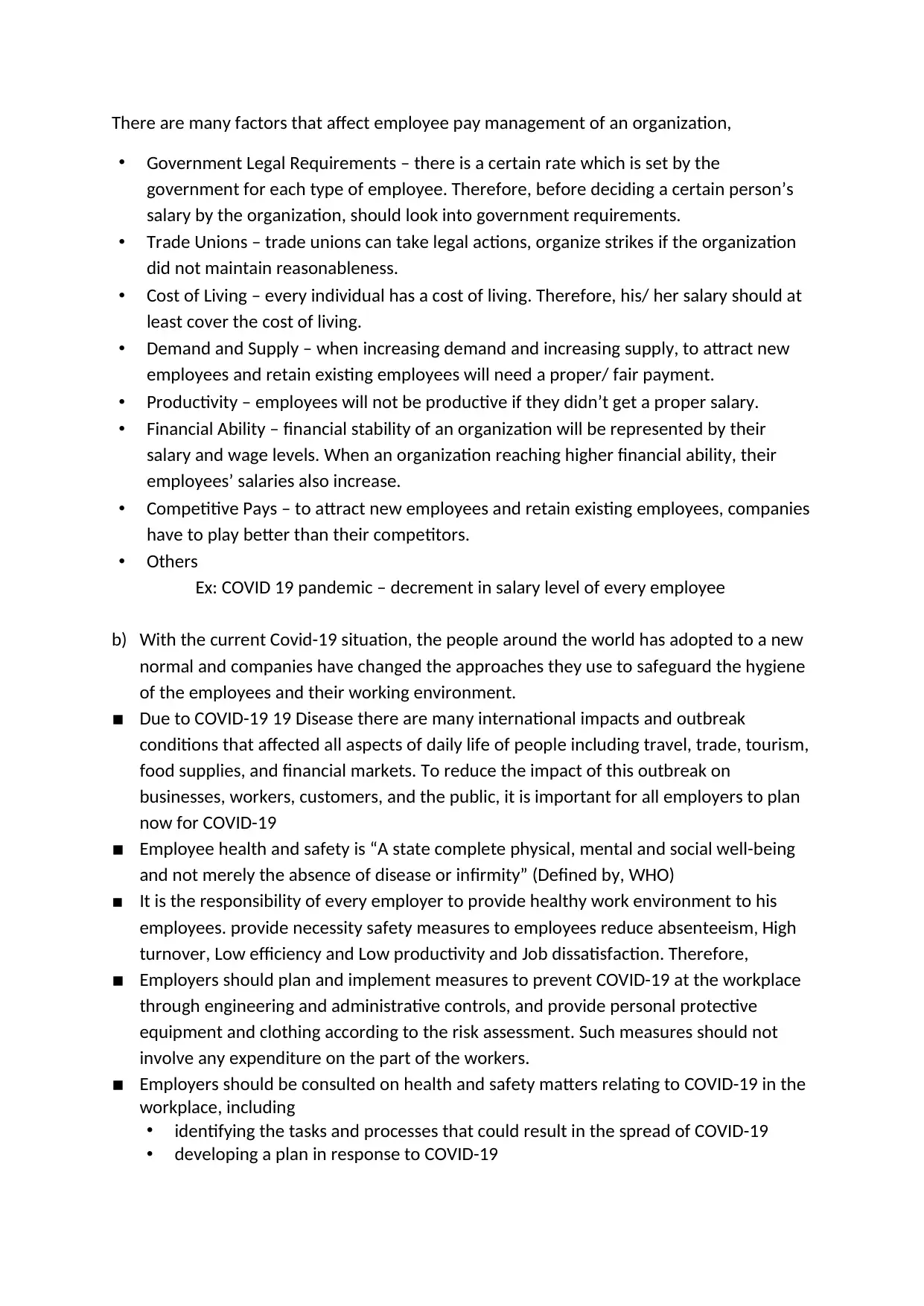
There are many factors that affect employee pay management of an organization,
• Government Legal Requirements – there is a certain rate which is set by the
government for each type of employee. Therefore, before deciding a certain person’s
salary by the organization, should look into government requirements.
• Trade Unions – trade unions can take legal actions, organize strikes if the organization
did not maintain reasonableness.
• Cost of Living – every individual has a cost of living. Therefore, his/ her salary should at
least cover the cost of living.
• Demand and Supply – when increasing demand and increasing supply, to attract new
employees and retain existing employees will need a proper/ fair payment.
• Productivity – employees will not be productive if they didn’t get a proper salary.
• Financial Ability – financial stability of an organization will be represented by their
salary and wage levels. When an organization reaching higher financial ability, their
employees’ salaries also increase.
• Competitive Pays – to attract new employees and retain existing employees, companies
have to play better than their competitors.
• Others
Ex: COVID 19 pandemic – decrement in salary level of every employee
b) With the current Covid-19 situation, the people around the world has adopted to a new
normal and companies have changed the approaches they use to safeguard the hygiene
of the employees and their working environment.
▪ Due to COVID-19 19 Disease there are many international impacts and outbreak
conditions that affected all aspects of daily life of people including travel, trade, tourism,
food supplies, and financial markets. To reduce the impact of this outbreak on
businesses, workers, customers, and the public, it is important for all employers to plan
now for COVID-19
▪ Employee health and safety is “A state complete physical, mental and social well-being
and not merely the absence of disease or infirmity” (Defined by, WHO)
▪ It is the responsibility of every employer to provide healthy work environment to his
employees. provide necessity safety measures to employees reduce absenteeism, High
turnover, Low efficiency and Low productivity and Job dissatisfaction. Therefore,
▪ Employers should plan and implement measures to prevent COVID-19 at the workplace
through engineering and administrative controls, and provide personal protective
equipment and clothing according to the risk assessment. Such measures should not
involve any expenditure on the part of the workers.
▪ Employers should be consulted on health and safety matters relating to COVID-19 in the
workplace, including
• identifying the tasks and processes that could result in the spread of COVID-19
• developing a plan in response to COVID-19
• Government Legal Requirements – there is a certain rate which is set by the
government for each type of employee. Therefore, before deciding a certain person’s
salary by the organization, should look into government requirements.
• Trade Unions – trade unions can take legal actions, organize strikes if the organization
did not maintain reasonableness.
• Cost of Living – every individual has a cost of living. Therefore, his/ her salary should at
least cover the cost of living.
• Demand and Supply – when increasing demand and increasing supply, to attract new
employees and retain existing employees will need a proper/ fair payment.
• Productivity – employees will not be productive if they didn’t get a proper salary.
• Financial Ability – financial stability of an organization will be represented by their
salary and wage levels. When an organization reaching higher financial ability, their
employees’ salaries also increase.
• Competitive Pays – to attract new employees and retain existing employees, companies
have to play better than their competitors.
• Others
Ex: COVID 19 pandemic – decrement in salary level of every employee
b) With the current Covid-19 situation, the people around the world has adopted to a new
normal and companies have changed the approaches they use to safeguard the hygiene
of the employees and their working environment.
▪ Due to COVID-19 19 Disease there are many international impacts and outbreak
conditions that affected all aspects of daily life of people including travel, trade, tourism,
food supplies, and financial markets. To reduce the impact of this outbreak on
businesses, workers, customers, and the public, it is important for all employers to plan
now for COVID-19
▪ Employee health and safety is “A state complete physical, mental and social well-being
and not merely the absence of disease or infirmity” (Defined by, WHO)
▪ It is the responsibility of every employer to provide healthy work environment to his
employees. provide necessity safety measures to employees reduce absenteeism, High
turnover, Low efficiency and Low productivity and Job dissatisfaction. Therefore,
▪ Employers should plan and implement measures to prevent COVID-19 at the workplace
through engineering and administrative controls, and provide personal protective
equipment and clothing according to the risk assessment. Such measures should not
involve any expenditure on the part of the workers.
▪ Employers should be consulted on health and safety matters relating to COVID-19 in the
workplace, including
• identifying the tasks and processes that could result in the spread of COVID-19
• developing a plan in response to COVID-19
Paraphrase This Document
Need a fresh take? Get an instant paraphrase of this document with our AI Paraphraser
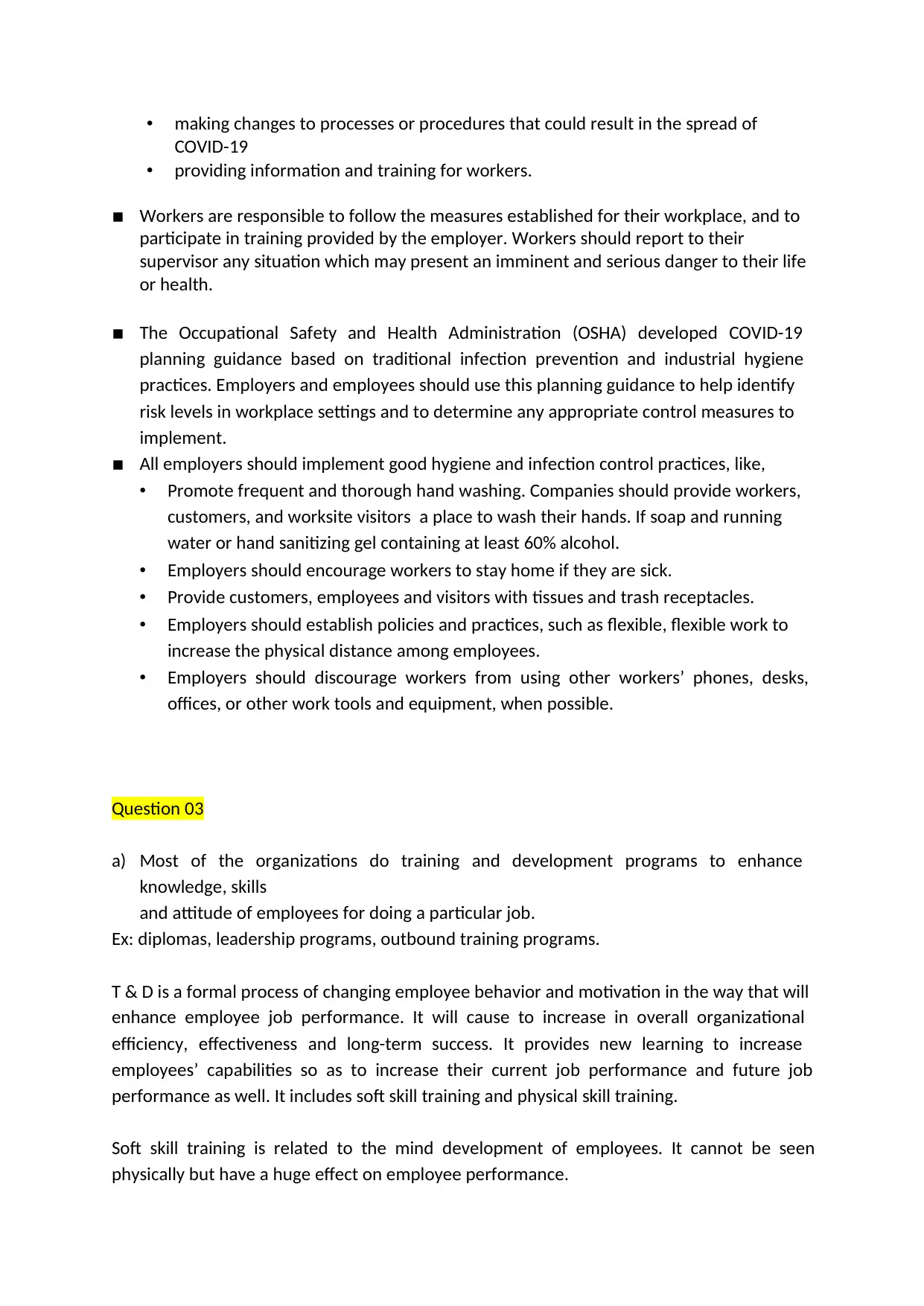
• making changes to processes or procedures that could result in the spread of
COVID-19
• providing information and training for workers.
▪ Workers are responsible to follow the measures established for their workplace, and to
participate in training provided by the employer. Workers should report to their
supervisor any situation which may present an imminent and serious danger to their life
or health.
▪ The Occupational Safety and Health Administration (OSHA) developed COVID-19
planning guidance based on traditional infection prevention and industrial hygiene
practices. Employers and employees should use this planning guidance to help identify
risk levels in workplace settings and to determine any appropriate control measures to
implement.
▪ All employers should implement good hygiene and infection control practices, like,
• Promote frequent and thorough hand washing. Companies should provide workers,
customers, and worksite visitors a place to wash their hands. If soap and running
water or hand sanitizing gel containing at least 60% alcohol.
• Employers should encourage workers to stay home if they are sick.
• Provide customers, employees and visitors with tissues and trash receptacles.
• Employers should establish policies and practices, such as flexible, flexible work to
increase the physical distance among employees.
• Employers should discourage workers from using other workers’ phones, desks,
offices, or other work tools and equipment, when possible.
Question 03
a) Most of the organizations do training and development programs to enhance
knowledge, skills
and attitude of employees for doing a particular job.
Ex: diplomas, leadership programs, outbound training programs.
T & D is a formal process of changing employee behavior and motivation in the way that will
enhance employee job performance. It will cause to increase in overall organizational
efficiency, effectiveness and long-term success. It provides new learning to increase
employees’ capabilities so as to increase their current job performance and future job
performance as well. It includes soft skill training and physical skill training.
Soft skill training is related to the mind development of employees. It cannot be seen
physically but have a huge effect on employee performance.
COVID-19
• providing information and training for workers.
▪ Workers are responsible to follow the measures established for their workplace, and to
participate in training provided by the employer. Workers should report to their
supervisor any situation which may present an imminent and serious danger to their life
or health.
▪ The Occupational Safety and Health Administration (OSHA) developed COVID-19
planning guidance based on traditional infection prevention and industrial hygiene
practices. Employers and employees should use this planning guidance to help identify
risk levels in workplace settings and to determine any appropriate control measures to
implement.
▪ All employers should implement good hygiene and infection control practices, like,
• Promote frequent and thorough hand washing. Companies should provide workers,
customers, and worksite visitors a place to wash their hands. If soap and running
water or hand sanitizing gel containing at least 60% alcohol.
• Employers should encourage workers to stay home if they are sick.
• Provide customers, employees and visitors with tissues and trash receptacles.
• Employers should establish policies and practices, such as flexible, flexible work to
increase the physical distance among employees.
• Employers should discourage workers from using other workers’ phones, desks,
offices, or other work tools and equipment, when possible.
Question 03
a) Most of the organizations do training and development programs to enhance
knowledge, skills
and attitude of employees for doing a particular job.
Ex: diplomas, leadership programs, outbound training programs.
T & D is a formal process of changing employee behavior and motivation in the way that will
enhance employee job performance. It will cause to increase in overall organizational
efficiency, effectiveness and long-term success. It provides new learning to increase
employees’ capabilities so as to increase their current job performance and future job
performance as well. It includes soft skill training and physical skill training.
Soft skill training is related to the mind development of employees. It cannot be seen
physically but have a huge effect on employee performance.
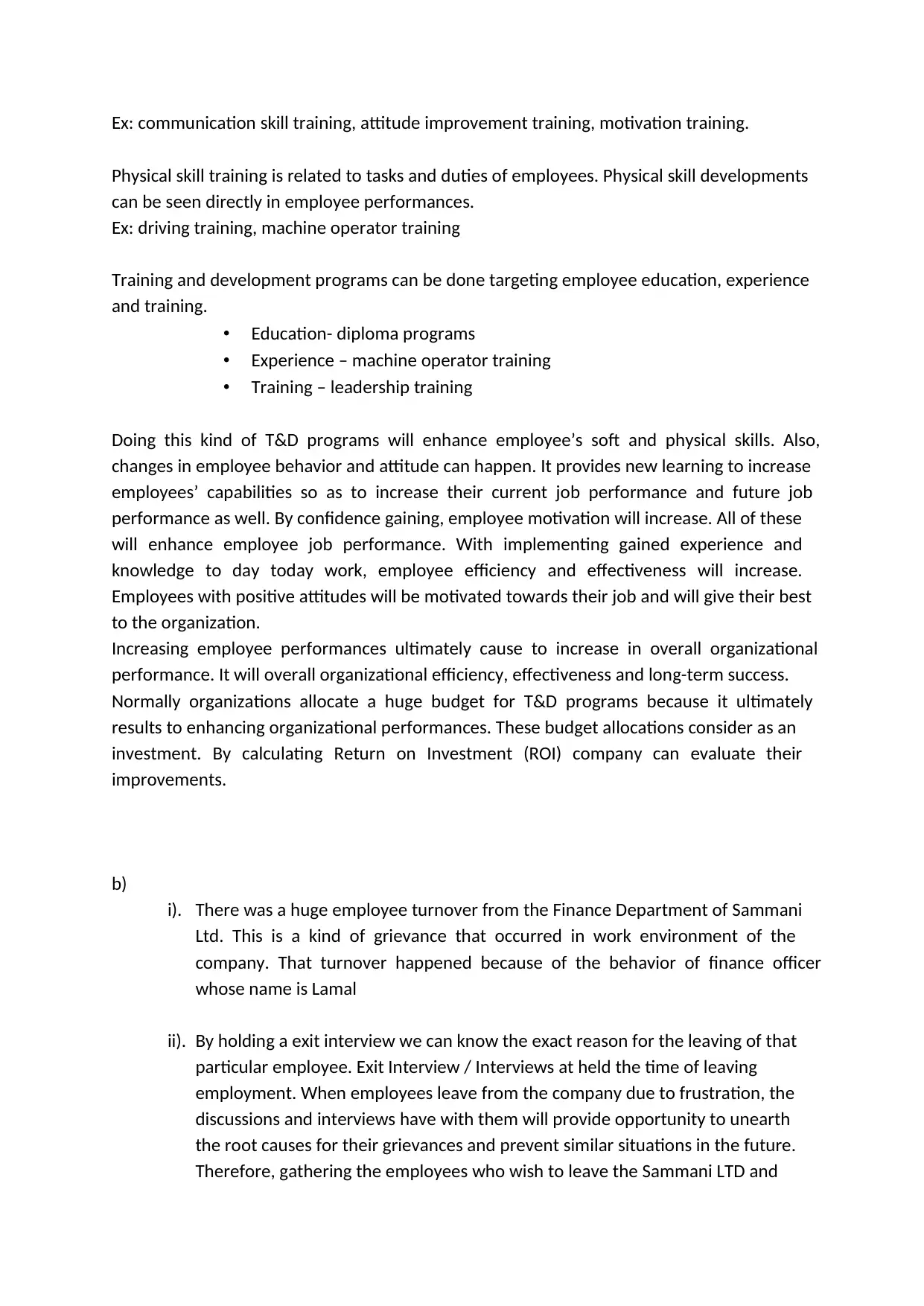
Ex: communication skill training, attitude improvement training, motivation training.
Physical skill training is related to tasks and duties of employees. Physical skill developments
can be seen directly in employee performances.
Ex: driving training, machine operator training
Training and development programs can be done targeting employee education, experience
and training.
• Education- diploma programs
• Experience – machine operator training
• Training – leadership training
Doing this kind of T&D programs will enhance employee’s soft and physical skills. Also,
changes in employee behavior and attitude can happen. It provides new learning to increase
employees’ capabilities so as to increase their current job performance and future job
performance as well. By confidence gaining, employee motivation will increase. All of these
will enhance employee job performance. With implementing gained experience and
knowledge to day today work, employee efficiency and effectiveness will increase.
Employees with positive attitudes will be motivated towards their job and will give their best
to the organization.
Increasing employee performances ultimately cause to increase in overall organizational
performance. It will overall organizational efficiency, effectiveness and long-term success.
Normally organizations allocate a huge budget for T&D programs because it ultimately
results to enhancing organizational performances. These budget allocations consider as an
investment. By calculating Return on Investment (ROI) company can evaluate their
improvements.
b)
i). There was a huge employee turnover from the Finance Department of Sammani
Ltd. This is a kind of grievance that occurred in work environment of the
company. That turnover happened because of the behavior of finance officer
whose name is Lamal
ii). By holding a exit interview we can know the exact reason for the leaving of that
particular employee. Exit Interview / Interviews at held the time of leaving
employment. When employees leave from the company due to frustration, the
discussions and interviews have with them will provide opportunity to unearth
the root causes for their grievances and prevent similar situations in the future.
Therefore, gathering the employees who wish to leave the Sammani LTD and
Physical skill training is related to tasks and duties of employees. Physical skill developments
can be seen directly in employee performances.
Ex: driving training, machine operator training
Training and development programs can be done targeting employee education, experience
and training.
• Education- diploma programs
• Experience – machine operator training
• Training – leadership training
Doing this kind of T&D programs will enhance employee’s soft and physical skills. Also,
changes in employee behavior and attitude can happen. It provides new learning to increase
employees’ capabilities so as to increase their current job performance and future job
performance as well. By confidence gaining, employee motivation will increase. All of these
will enhance employee job performance. With implementing gained experience and
knowledge to day today work, employee efficiency and effectiveness will increase.
Employees with positive attitudes will be motivated towards their job and will give their best
to the organization.
Increasing employee performances ultimately cause to increase in overall organizational
performance. It will overall organizational efficiency, effectiveness and long-term success.
Normally organizations allocate a huge budget for T&D programs because it ultimately
results to enhancing organizational performances. These budget allocations consider as an
investment. By calculating Return on Investment (ROI) company can evaluate their
improvements.
b)
i). There was a huge employee turnover from the Finance Department of Sammani
Ltd. This is a kind of grievance that occurred in work environment of the
company. That turnover happened because of the behavior of finance officer
whose name is Lamal
ii). By holding a exit interview we can know the exact reason for the leaving of that
particular employee. Exit Interview / Interviews at held the time of leaving
employment. When employees leave from the company due to frustration, the
discussions and interviews have with them will provide opportunity to unearth
the root causes for their grievances and prevent similar situations in the future.
Therefore, gathering the employees who wish to leave the Sammani LTD and
⊘ This is a preview!⊘
Do you want full access?
Subscribe today to unlock all pages.

Trusted by 1+ million students worldwide
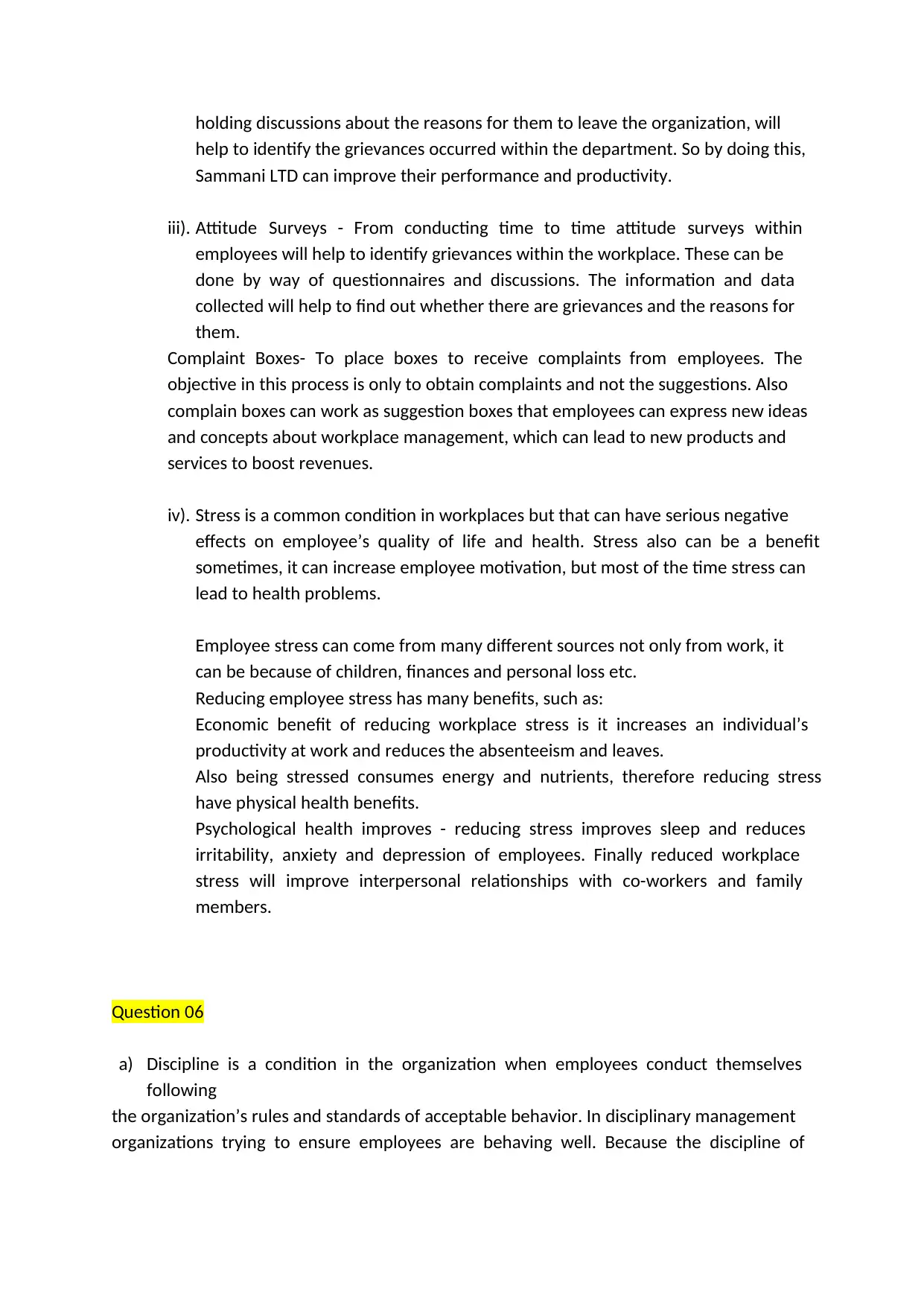
holding discussions about the reasons for them to leave the organization, will
help to identify the grievances occurred within the department. So by doing this,
Sammani LTD can improve their performance and productivity.
iii). Attitude Surveys - From conducting time to time attitude surveys within
employees will help to identify grievances within the workplace. These can be
done by way of questionnaires and discussions. The information and data
collected will help to find out whether there are grievances and the reasons for
them.
Complaint Boxes- To place boxes to receive complaints from employees. The
objective in this process is only to obtain complaints and not the suggestions. Also
complain boxes can work as suggestion boxes that employees can express new ideas
and concepts about workplace management, which can lead to new products and
services to boost revenues.
iv). Stress is a common condition in workplaces but that can have serious negative
effects on employee’s quality of life and health. Stress also can be a benefit
sometimes, it can increase employee motivation, but most of the time stress can
lead to health problems.
Employee stress can come from many different sources not only from work, it
can be because of children, finances and personal loss etc.
Reducing employee stress has many benefits, such as:
Economic benefit of reducing workplace stress is it increases an individual’s
productivity at work and reduces the absenteeism and leaves.
Also being stressed consumes energy and nutrients, therefore reducing stress
have physical health benefits.
Psychological health improves - reducing stress improves sleep and reduces
irritability, anxiety and depression of employees. Finally reduced workplace
stress will improve interpersonal relationships with co-workers and family
members.
Question 06
a) Discipline is a condition in the organization when employees conduct themselves
following
the organization’s rules and standards of acceptable behavior. In disciplinary management
organizations trying to ensure employees are behaving well. Because the discipline of
help to identify the grievances occurred within the department. So by doing this,
Sammani LTD can improve their performance and productivity.
iii). Attitude Surveys - From conducting time to time attitude surveys within
employees will help to identify grievances within the workplace. These can be
done by way of questionnaires and discussions. The information and data
collected will help to find out whether there are grievances and the reasons for
them.
Complaint Boxes- To place boxes to receive complaints from employees. The
objective in this process is only to obtain complaints and not the suggestions. Also
complain boxes can work as suggestion boxes that employees can express new ideas
and concepts about workplace management, which can lead to new products and
services to boost revenues.
iv). Stress is a common condition in workplaces but that can have serious negative
effects on employee’s quality of life and health. Stress also can be a benefit
sometimes, it can increase employee motivation, but most of the time stress can
lead to health problems.
Employee stress can come from many different sources not only from work, it
can be because of children, finances and personal loss etc.
Reducing employee stress has many benefits, such as:
Economic benefit of reducing workplace stress is it increases an individual’s
productivity at work and reduces the absenteeism and leaves.
Also being stressed consumes energy and nutrients, therefore reducing stress
have physical health benefits.
Psychological health improves - reducing stress improves sleep and reduces
irritability, anxiety and depression of employees. Finally reduced workplace
stress will improve interpersonal relationships with co-workers and family
members.
Question 06
a) Discipline is a condition in the organization when employees conduct themselves
following
the organization’s rules and standards of acceptable behavior. In disciplinary management
organizations trying to ensure employees are behaving well. Because the discipline of
Paraphrase This Document
Need a fresh take? Get an instant paraphrase of this document with our AI Paraphraser
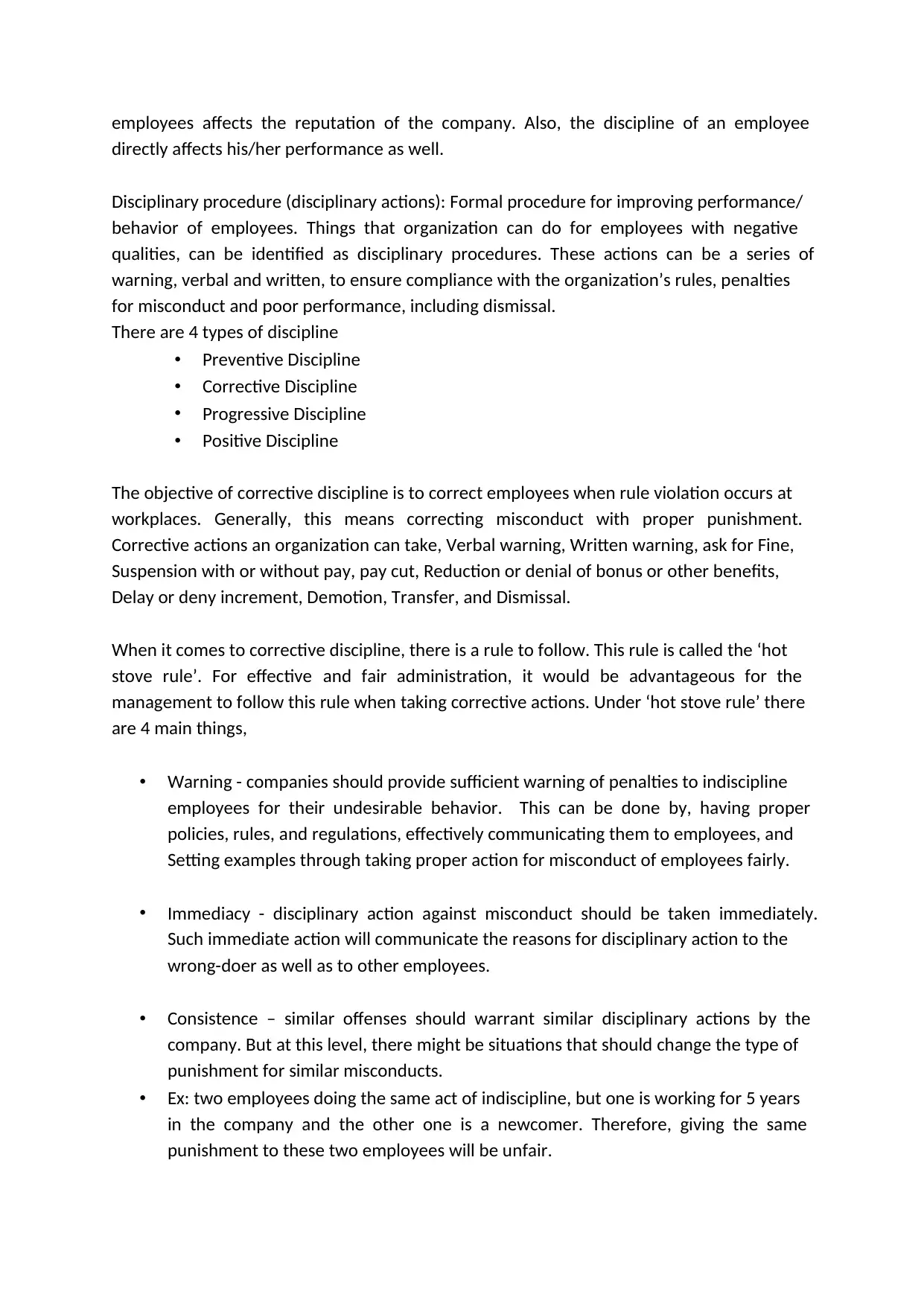
employees affects the reputation of the company. Also, the discipline of an employee
directly affects his/her performance as well.
Disciplinary procedure (disciplinary actions): Formal procedure for improving performance/
behavior of employees. Things that organization can do for employees with negative
qualities, can be identified as disciplinary procedures. These actions can be a series of
warning, verbal and written, to ensure compliance with the organization’s rules, penalties
for misconduct and poor performance, including dismissal.
There are 4 types of discipline
• Preventive Discipline
• Corrective Discipline
• Progressive Discipline
• Positive Discipline
The objective of corrective discipline is to correct employees when rule violation occurs at
workplaces. Generally, this means correcting misconduct with proper punishment.
Corrective actions an organization can take, Verbal warning, Written warning, ask for Fine,
Suspension with or without pay, pay cut, Reduction or denial of bonus or other benefits,
Delay or deny increment, Demotion, Transfer, and Dismissal.
When it comes to corrective discipline, there is a rule to follow. This rule is called the ‘hot
stove rule’. For effective and fair administration, it would be advantageous for the
management to follow this rule when taking corrective actions. Under ‘hot stove rule’ there
are 4 main things,
• Warning - companies should provide sufficient warning of penalties to indiscipline
employees for their undesirable behavior. This can be done by, having proper
policies, rules, and regulations, effectively communicating them to employees, and
Setting examples through taking proper action for misconduct of employees fairly.
• Immediacy - disciplinary action against misconduct should be taken immediately.
Such immediate action will communicate the reasons for disciplinary action to the
wrong-doer as well as to other employees.
• Consistence – similar offenses should warrant similar disciplinary actions by the
company. But at this level, there might be situations that should change the type of
punishment for similar misconducts.
• Ex: two employees doing the same act of indiscipline, but one is working for 5 years
in the company and the other one is a newcomer. Therefore, giving the same
punishment to these two employees will be unfair.
directly affects his/her performance as well.
Disciplinary procedure (disciplinary actions): Formal procedure for improving performance/
behavior of employees. Things that organization can do for employees with negative
qualities, can be identified as disciplinary procedures. These actions can be a series of
warning, verbal and written, to ensure compliance with the organization’s rules, penalties
for misconduct and poor performance, including dismissal.
There are 4 types of discipline
• Preventive Discipline
• Corrective Discipline
• Progressive Discipline
• Positive Discipline
The objective of corrective discipline is to correct employees when rule violation occurs at
workplaces. Generally, this means correcting misconduct with proper punishment.
Corrective actions an organization can take, Verbal warning, Written warning, ask for Fine,
Suspension with or without pay, pay cut, Reduction or denial of bonus or other benefits,
Delay or deny increment, Demotion, Transfer, and Dismissal.
When it comes to corrective discipline, there is a rule to follow. This rule is called the ‘hot
stove rule’. For effective and fair administration, it would be advantageous for the
management to follow this rule when taking corrective actions. Under ‘hot stove rule’ there
are 4 main things,
• Warning - companies should provide sufficient warning of penalties to indiscipline
employees for their undesirable behavior. This can be done by, having proper
policies, rules, and regulations, effectively communicating them to employees, and
Setting examples through taking proper action for misconduct of employees fairly.
• Immediacy - disciplinary action against misconduct should be taken immediately.
Such immediate action will communicate the reasons for disciplinary action to the
wrong-doer as well as to other employees.
• Consistence – similar offenses should warrant similar disciplinary actions by the
company. But at this level, there might be situations that should change the type of
punishment for similar misconducts.
• Ex: two employees doing the same act of indiscipline, but one is working for 5 years
in the company and the other one is a newcomer. Therefore, giving the same
punishment to these two employees will be unfair.
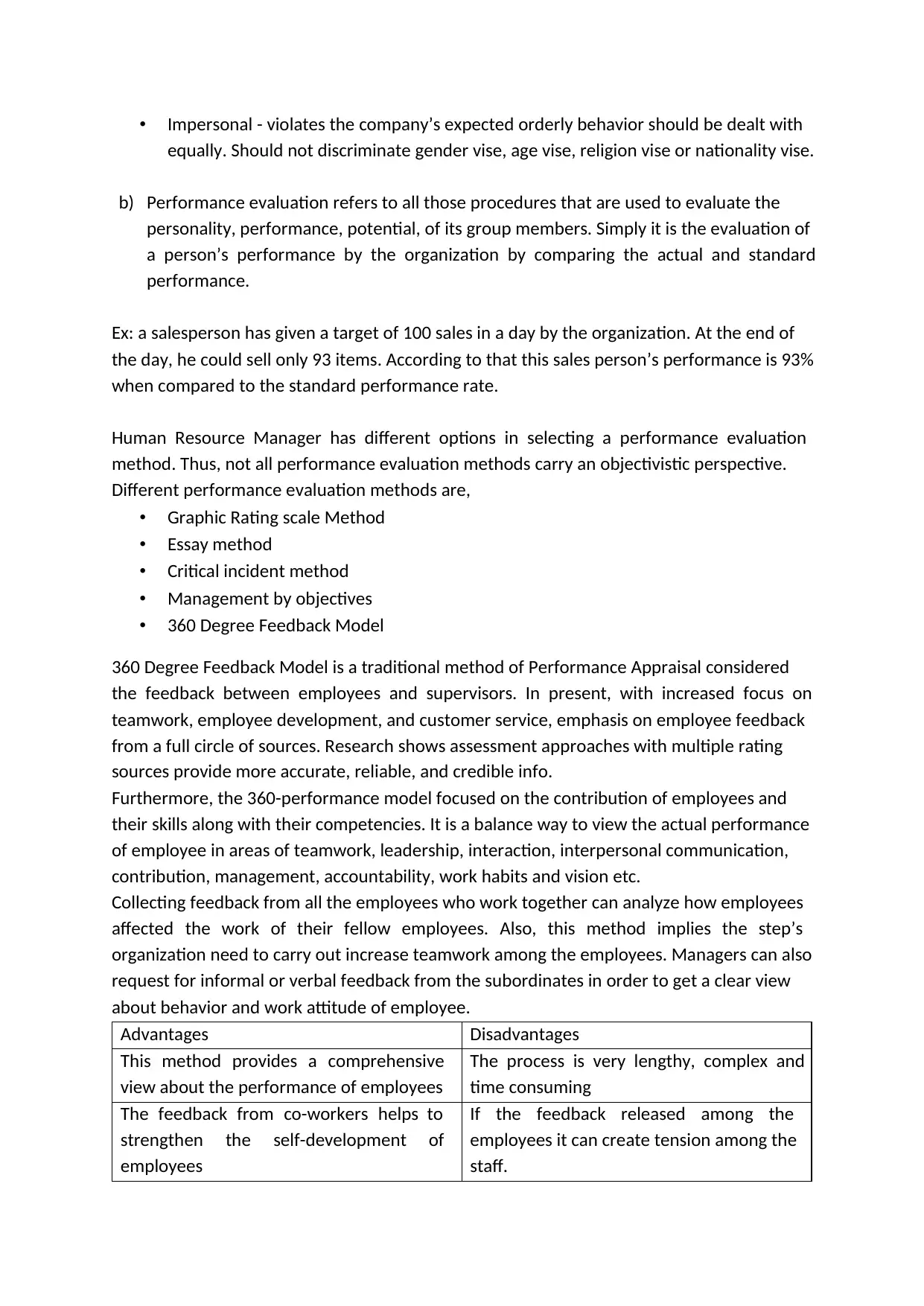
• Impersonal - violates the company’s expected orderly behavior should be dealt with
equally. Should not discriminate gender vise, age vise, religion vise or nationality vise.
b) Performance evaluation refers to all those procedures that are used to evaluate the
personality, performance, potential, of its group members. Simply it is the evaluation of
a person’s performance by the organization by comparing the actual and standard
performance.
Ex: a salesperson has given a target of 100 sales in a day by the organization. At the end of
the day, he could sell only 93 items. According to that this sales person’s performance is 93%
when compared to the standard performance rate.
Human Resource Manager has different options in selecting a performance evaluation
method. Thus, not all performance evaluation methods carry an objectivistic perspective.
Different performance evaluation methods are,
• Graphic Rating scale Method
• Essay method
• Critical incident method
• Management by objectives
• 360 Degree Feedback Model
360 Degree Feedback Model is a traditional method of Performance Appraisal considered
the feedback between employees and supervisors. In present, with increased focus on
teamwork, employee development, and customer service, emphasis on employee feedback
from a full circle of sources. Research shows assessment approaches with multiple rating
sources provide more accurate, reliable, and credible info.
Furthermore, the 360-performance model focused on the contribution of employees and
their skills along with their competencies. It is a balance way to view the actual performance
of employee in areas of teamwork, leadership, interaction, interpersonal communication,
contribution, management, accountability, work habits and vision etc.
Collecting feedback from all the employees who work together can analyze how employees
affected the work of their fellow employees. Also, this method implies the step’s
organization need to carry out increase teamwork among the employees. Managers can also
request for informal or verbal feedback from the subordinates in order to get a clear view
about behavior and work attitude of employee.
Advantages Disadvantages
This method provides a comprehensive
view about the performance of employees
The process is very lengthy, complex and
time consuming
The feedback from co-workers helps to
strengthen the self-development of
employees
If the feedback released among the
employees it can create tension among the
staff.
equally. Should not discriminate gender vise, age vise, religion vise or nationality vise.
b) Performance evaluation refers to all those procedures that are used to evaluate the
personality, performance, potential, of its group members. Simply it is the evaluation of
a person’s performance by the organization by comparing the actual and standard
performance.
Ex: a salesperson has given a target of 100 sales in a day by the organization. At the end of
the day, he could sell only 93 items. According to that this sales person’s performance is 93%
when compared to the standard performance rate.
Human Resource Manager has different options in selecting a performance evaluation
method. Thus, not all performance evaluation methods carry an objectivistic perspective.
Different performance evaluation methods are,
• Graphic Rating scale Method
• Essay method
• Critical incident method
• Management by objectives
• 360 Degree Feedback Model
360 Degree Feedback Model is a traditional method of Performance Appraisal considered
the feedback between employees and supervisors. In present, with increased focus on
teamwork, employee development, and customer service, emphasis on employee feedback
from a full circle of sources. Research shows assessment approaches with multiple rating
sources provide more accurate, reliable, and credible info.
Furthermore, the 360-performance model focused on the contribution of employees and
their skills along with their competencies. It is a balance way to view the actual performance
of employee in areas of teamwork, leadership, interaction, interpersonal communication,
contribution, management, accountability, work habits and vision etc.
Collecting feedback from all the employees who work together can analyze how employees
affected the work of their fellow employees. Also, this method implies the step’s
organization need to carry out increase teamwork among the employees. Managers can also
request for informal or verbal feedback from the subordinates in order to get a clear view
about behavior and work attitude of employee.
Advantages Disadvantages
This method provides a comprehensive
view about the performance of employees
The process is very lengthy, complex and
time consuming
The feedback from co-workers helps to
strengthen the self-development of
employees
If the feedback released among the
employees it can create tension among the
staff.
⊘ This is a preview!⊘
Do you want full access?
Subscribe today to unlock all pages.

Trusted by 1+ million students worldwide
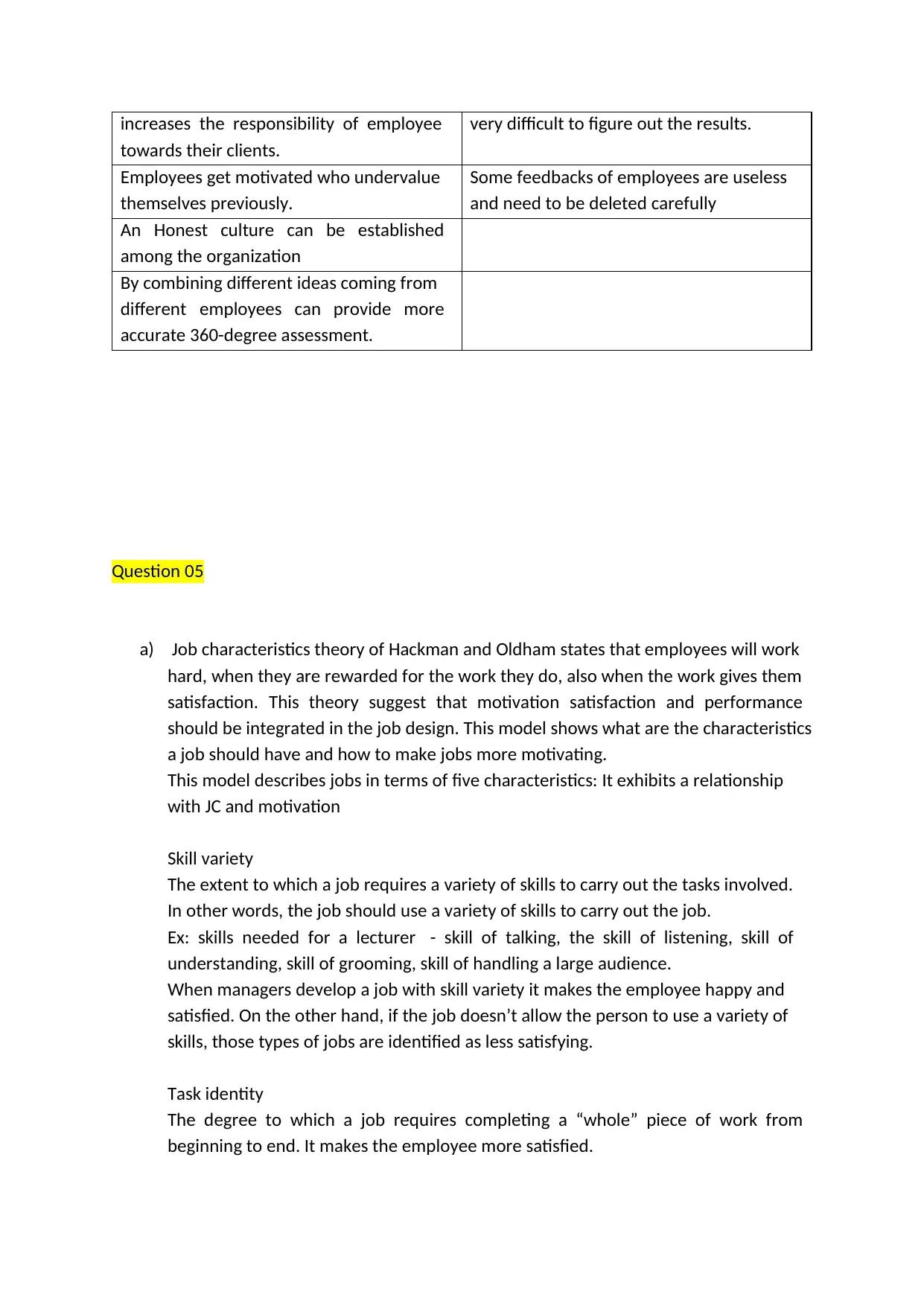
increases the responsibility of employee
towards their clients.
very difficult to figure out the results.
Employees get motivated who undervalue
themselves previously.
Some feedbacks of employees are useless
and need to be deleted carefully
An Honest culture can be established
among the organization
By combining different ideas coming from
different employees can provide more
accurate 360-degree assessment.
Question 05
a) Job characteristics theory of Hackman and Oldham states that employees will work
hard, when they are rewarded for the work they do, also when the work gives them
satisfaction. This theory suggest that motivation satisfaction and performance
should be integrated in the job design. This model shows what are the characteristics
a job should have and how to make jobs more motivating.
This model describes jobs in terms of five characteristics: It exhibits a relationship
with JC and motivation
Skill variety
The extent to which a job requires a variety of skills to carry out the tasks involved.
In other words, the job should use a variety of skills to carry out the job.
Ex: skills needed for a lecturer - skill of talking, the skill of listening, skill of
understanding, skill of grooming, skill of handling a large audience.
When managers develop a job with skill variety it makes the employee happy and
satisfied. On the other hand, if the job doesn’t allow the person to use a variety of
skills, those types of jobs are identified as less satisfying.
Task identity
The degree to which a job requires completing a “whole” piece of work from
beginning to end. It makes the employee more satisfied.
towards their clients.
very difficult to figure out the results.
Employees get motivated who undervalue
themselves previously.
Some feedbacks of employees are useless
and need to be deleted carefully
An Honest culture can be established
among the organization
By combining different ideas coming from
different employees can provide more
accurate 360-degree assessment.
Question 05
a) Job characteristics theory of Hackman and Oldham states that employees will work
hard, when they are rewarded for the work they do, also when the work gives them
satisfaction. This theory suggest that motivation satisfaction and performance
should be integrated in the job design. This model shows what are the characteristics
a job should have and how to make jobs more motivating.
This model describes jobs in terms of five characteristics: It exhibits a relationship
with JC and motivation
Skill variety
The extent to which a job requires a variety of skills to carry out the tasks involved.
In other words, the job should use a variety of skills to carry out the job.
Ex: skills needed for a lecturer - skill of talking, the skill of listening, skill of
understanding, skill of grooming, skill of handling a large audience.
When managers develop a job with skill variety it makes the employee happy and
satisfied. On the other hand, if the job doesn’t allow the person to use a variety of
skills, those types of jobs are identified as less satisfying.
Task identity
The degree to which a job requires completing a “whole” piece of work from
beginning to end. It makes the employee more satisfied.
Paraphrase This Document
Need a fresh take? Get an instant paraphrase of this document with our AI Paraphraser
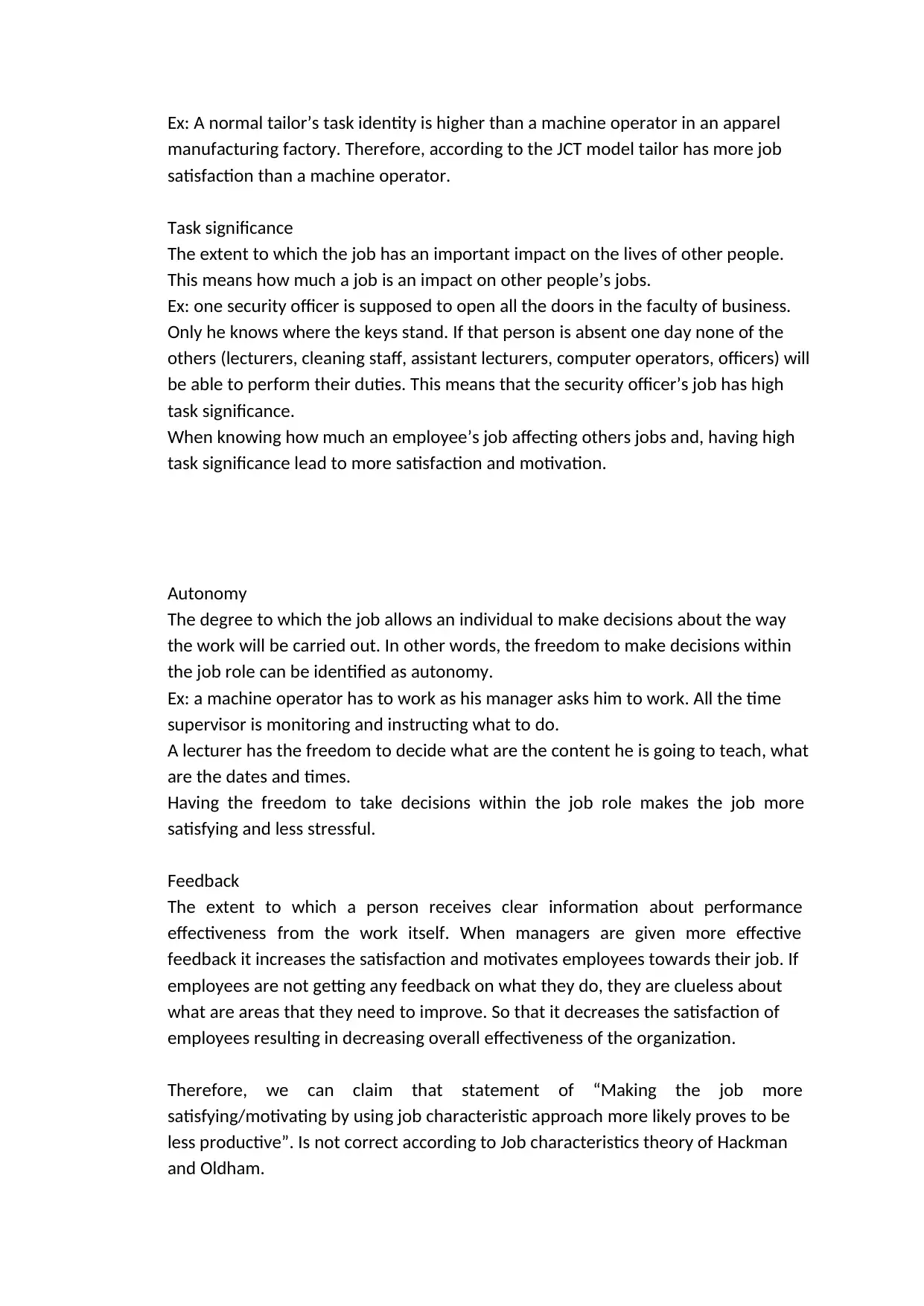
Ex: A normal tailor’s task identity is higher than a machine operator in an apparel
manufacturing factory. Therefore, according to the JCT model tailor has more job
satisfaction than a machine operator.
Task significance
The extent to which the job has an important impact on the lives of other people.
This means how much a job is an impact on other people’s jobs.
Ex: one security officer is supposed to open all the doors in the faculty of business.
Only he knows where the keys stand. If that person is absent one day none of the
others (lecturers, cleaning staff, assistant lecturers, computer operators, officers) will
be able to perform their duties. This means that the security officer’s job has high
task significance.
When knowing how much an employee’s job affecting others jobs and, having high
task significance lead to more satisfaction and motivation.
Autonomy
The degree to which the job allows an individual to make decisions about the way
the work will be carried out. In other words, the freedom to make decisions within
the job role can be identified as autonomy.
Ex: a machine operator has to work as his manager asks him to work. All the time
supervisor is monitoring and instructing what to do.
A lecturer has the freedom to decide what are the content he is going to teach, what
are the dates and times.
Having the freedom to take decisions within the job role makes the job more
satisfying and less stressful.
Feedback
The extent to which a person receives clear information about performance
effectiveness from the work itself. When managers are given more effective
feedback it increases the satisfaction and motivates employees towards their job. If
employees are not getting any feedback on what they do, they are clueless about
what are areas that they need to improve. So that it decreases the satisfaction of
employees resulting in decreasing overall effectiveness of the organization.
Therefore, we can claim that statement of “Making the job more
satisfying/motivating by using job characteristic approach more likely proves to be
less productive”. Is not correct according to Job characteristics theory of Hackman
and Oldham.
manufacturing factory. Therefore, according to the JCT model tailor has more job
satisfaction than a machine operator.
Task significance
The extent to which the job has an important impact on the lives of other people.
This means how much a job is an impact on other people’s jobs.
Ex: one security officer is supposed to open all the doors in the faculty of business.
Only he knows where the keys stand. If that person is absent one day none of the
others (lecturers, cleaning staff, assistant lecturers, computer operators, officers) will
be able to perform their duties. This means that the security officer’s job has high
task significance.
When knowing how much an employee’s job affecting others jobs and, having high
task significance lead to more satisfaction and motivation.
Autonomy
The degree to which the job allows an individual to make decisions about the way
the work will be carried out. In other words, the freedom to make decisions within
the job role can be identified as autonomy.
Ex: a machine operator has to work as his manager asks him to work. All the time
supervisor is monitoring and instructing what to do.
A lecturer has the freedom to decide what are the content he is going to teach, what
are the dates and times.
Having the freedom to take decisions within the job role makes the job more
satisfying and less stressful.
Feedback
The extent to which a person receives clear information about performance
effectiveness from the work itself. When managers are given more effective
feedback it increases the satisfaction and motivates employees towards their job. If
employees are not getting any feedback on what they do, they are clueless about
what are areas that they need to improve. So that it decreases the satisfaction of
employees resulting in decreasing overall effectiveness of the organization.
Therefore, we can claim that statement of “Making the job more
satisfying/motivating by using job characteristic approach more likely proves to be
less productive”. Is not correct according to Job characteristics theory of Hackman
and Oldham.
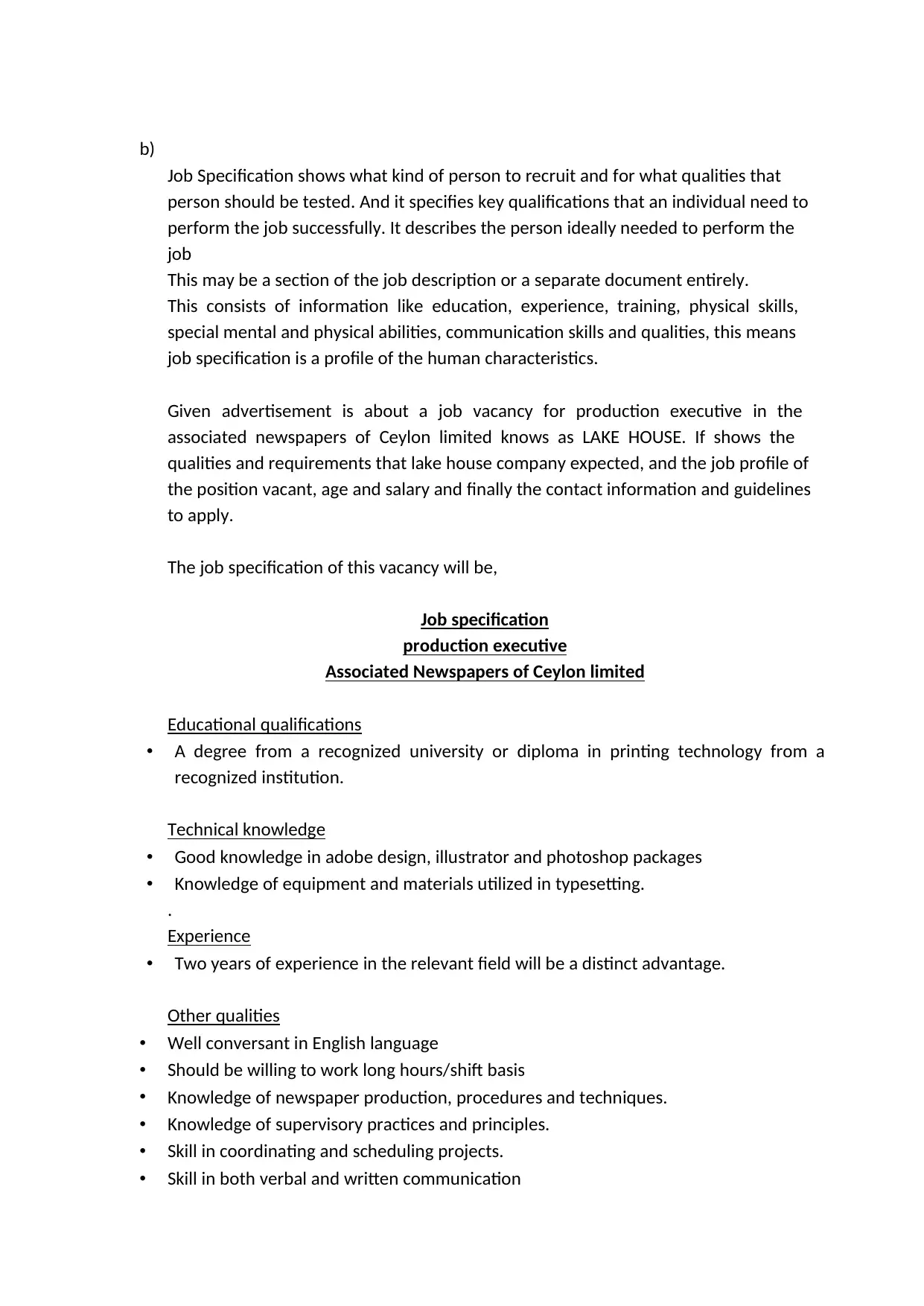
b)
Job Specification shows what kind of person to recruit and for what qualities that
person should be tested. And it specifies key qualifications that an individual need to
perform the job successfully. It describes the person ideally needed to perform the
job
This may be a section of the job description or a separate document entirely.
This consists of information like education, experience, training, physical skills,
special mental and physical abilities, communication skills and qualities, this means
job specification is a profile of the human characteristics.
Given advertisement is about a job vacancy for production executive in the
associated newspapers of Ceylon limited knows as LAKE HOUSE. If shows the
qualities and requirements that lake house company expected, and the job profile of
the position vacant, age and salary and finally the contact information and guidelines
to apply.
The job specification of this vacancy will be,
Job specification
production executive
Associated Newspapers of Ceylon limited
Educational qualifications
• A degree from a recognized university or diploma in printing technology from a
recognized institution.
Technical knowledge
• Good knowledge in adobe design, illustrator and photoshop packages
• Knowledge of equipment and materials utilized in typesetting.
.
Experience
• Two years of experience in the relevant field will be a distinct advantage.
Other qualities
• Well conversant in English language
• Should be willing to work long hours/shift basis
• Knowledge of newspaper production, procedures and techniques.
• Knowledge of supervisory practices and principles.
• Skill in coordinating and scheduling projects.
• Skill in both verbal and written communication
Job Specification shows what kind of person to recruit and for what qualities that
person should be tested. And it specifies key qualifications that an individual need to
perform the job successfully. It describes the person ideally needed to perform the
job
This may be a section of the job description or a separate document entirely.
This consists of information like education, experience, training, physical skills,
special mental and physical abilities, communication skills and qualities, this means
job specification is a profile of the human characteristics.
Given advertisement is about a job vacancy for production executive in the
associated newspapers of Ceylon limited knows as LAKE HOUSE. If shows the
qualities and requirements that lake house company expected, and the job profile of
the position vacant, age and salary and finally the contact information and guidelines
to apply.
The job specification of this vacancy will be,
Job specification
production executive
Associated Newspapers of Ceylon limited
Educational qualifications
• A degree from a recognized university or diploma in printing technology from a
recognized institution.
Technical knowledge
• Good knowledge in adobe design, illustrator and photoshop packages
• Knowledge of equipment and materials utilized in typesetting.
.
Experience
• Two years of experience in the relevant field will be a distinct advantage.
Other qualities
• Well conversant in English language
• Should be willing to work long hours/shift basis
• Knowledge of newspaper production, procedures and techniques.
• Knowledge of supervisory practices and principles.
• Skill in coordinating and scheduling projects.
• Skill in both verbal and written communication
⊘ This is a preview!⊘
Do you want full access?
Subscribe today to unlock all pages.

Trusted by 1+ million students worldwide
1 out of 12
Related Documents
Your All-in-One AI-Powered Toolkit for Academic Success.
+13062052269
info@desklib.com
Available 24*7 on WhatsApp / Email
![[object Object]](/_next/static/media/star-bottom.7253800d.svg)
Unlock your academic potential
Copyright © 2020–2025 A2Z Services. All Rights Reserved. Developed and managed by ZUCOL.




